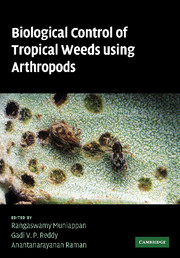Book contents
- Frontmatter
- Contents
- List of contributors
- Acknowledgments
- 1 Biological control of weeds in the tropics and sustainability
- 2 Acacia nilotica ssp. indica (L.) Willd. ex Del. (Mimosaceae)
- 3 Australian Acacia species (Mimosaceae) in South Africa
- 4 Ageratina adenophora (Sprengel) King and Robinson (Asteraceae)
- 5 Azolla filiculoides Lamarck (Azollaceae)
- 6 Cabomba caroliniana Gray (Cabombaceae)
- 7 Invasive cactus species (Cactaceae)
- 8 Chromolaena odorata (L.) King and Robinson (Asteraceae)
- 9 Clidemia hirta (L.) D. Don (Melastomataceae)
- 10 Coccinia grandis (L.) Voigt (Cucurbitaceae)
- 11 Eichhornia crassipes (Mart.) Solms–Laub. (Pontederiaceae)
- 12 Lantana camara Linn. (Verbenaceae)
- 13 Mimosa diplotricha C. Wright ex Sauvalle (Mimosaceae)
- 14 Mimosa pigra L. (Leguminosae)
- 15 Parthenium hysterophorus L. (Asteraceae)
- 16 Passiflora mollissima (HBK) Bailey (Passifloraceae)
- 17 Pistia stratiotes L. (Araceae)
- 18 Prosopis species (Leguminosae)
- 19 Salvinia molesta D. S. Mitchell (Salviniaceae)
- 20 Solanum mauritianum Scopoli (Solanaceae)
- 21 Application of natural antagonists including arthropods to resist weedy Striga (Oranbanchaceae) in tropical agroecosystems
- 22 Biological control of weeds in India
- 23 The role of International Institute of Tropical Agriculture in biological control of weeds
- 24 The role of Secretariat of the Pacific Community in the biological control of weeds in the Pacific Islands region – past, present, and future activities
- Index
4 - Ageratina adenophora (Sprengel) King and Robinson (Asteraceae)
Published online by Cambridge University Press: 04 August 2010
- Frontmatter
- Contents
- List of contributors
- Acknowledgments
- 1 Biological control of weeds in the tropics and sustainability
- 2 Acacia nilotica ssp. indica (L.) Willd. ex Del. (Mimosaceae)
- 3 Australian Acacia species (Mimosaceae) in South Africa
- 4 Ageratina adenophora (Sprengel) King and Robinson (Asteraceae)
- 5 Azolla filiculoides Lamarck (Azollaceae)
- 6 Cabomba caroliniana Gray (Cabombaceae)
- 7 Invasive cactus species (Cactaceae)
- 8 Chromolaena odorata (L.) King and Robinson (Asteraceae)
- 9 Clidemia hirta (L.) D. Don (Melastomataceae)
- 10 Coccinia grandis (L.) Voigt (Cucurbitaceae)
- 11 Eichhornia crassipes (Mart.) Solms–Laub. (Pontederiaceae)
- 12 Lantana camara Linn. (Verbenaceae)
- 13 Mimosa diplotricha C. Wright ex Sauvalle (Mimosaceae)
- 14 Mimosa pigra L. (Leguminosae)
- 15 Parthenium hysterophorus L. (Asteraceae)
- 16 Passiflora mollissima (HBK) Bailey (Passifloraceae)
- 17 Pistia stratiotes L. (Araceae)
- 18 Prosopis species (Leguminosae)
- 19 Salvinia molesta D. S. Mitchell (Salviniaceae)
- 20 Solanum mauritianum Scopoli (Solanaceae)
- 21 Application of natural antagonists including arthropods to resist weedy Striga (Oranbanchaceae) in tropical agroecosystems
- 22 Biological control of weeds in India
- 23 The role of International Institute of Tropical Agriculture in biological control of weeds
- 24 The role of Secretariat of the Pacific Community in the biological control of weeds in the Pacific Islands region – past, present, and future activities
- Index
Summary
Introduction
Ageratina adenophora (Sprengel) King and Robinson (=Eupatorium adenophorum, E. glandulosum, E. pasadense) (Asterales: Asteraceae) is popularly known as the Crofton weed; other common names are eupatory, sticky snakeroot, cat weed, hemp agrimony, sticky agrimony, Mexican devil, and sticky eupatorium in different parts of the world (Hoshovsky and Lichti, 2007). In Hawaii it is known as Maui pāmakani and pāmakani haole and in Nepal as banmara (killer of the forests). Usually, it grows into an erect herb (occasionally into a subshrub) of one to three meters in height, with trailing purplish to chocolate-brown branches that strike roots upon contact with soil, resulting in dense thickets (Bess and Haramoto, 1958). The base of the plant is woody and densely clothed with stalked glandular hairs. Leaves are dark green, opposite, deltoid-ovate, serrate, and purple underneath, and each grows to about 10 cm in length. Flowers are white and borne terminally in compound clusters in spring and summer. The seed is an achene, varying from elliptic to oblanceolate, often gibbous, 1.5–2 mm long, 0.3–0.5 mm wide; with five prominent ribs and five to 40 pappi with slender scabrous bristles (Hickman, 1993). Dispersal occurs by wind-borne seeds and each plant produces about 100,000 seeds per season. Seeds are also spread by water, as contaminants of agricultural produce, via sand and gravel used in road preparation, via soil sticking to animals, machinery, and vehicles, and by adhering to footwear or clothing of farm workers (Parsons, 1992).
- Type
- Chapter
- Information
- Biological Control of Tropical Weeds Using Arthropods , pp. 63 - 73Publisher: Cambridge University PressPrint publication year: 2009
- 18
- Cited by

